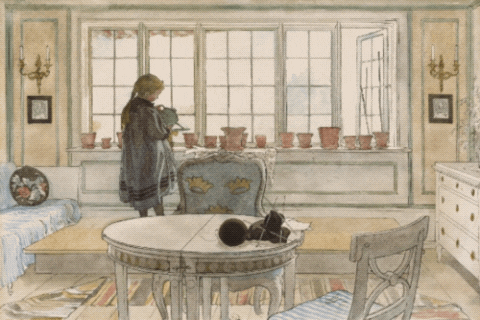Welcome to Dig It!: a newsletter featuring digital trends and practices from museums & cultural institutions. We try to make this newsletter one of the most inspiring mails you get every fortnight. If you enjoy this issue, please share it. We welcome feedback and are always interested in improving the newsletter!

Folding Screen with Design of Mt. Yoshino and Tatsuta River, Tokyo Fuji Art Museum, CC0.
In the last months, we have encountered a spirit of both curiosity and fear, change as well as resistance in this sector. While we see parts of the sector clearly expressing their longing for structural transformation, there are others who feel overtaxed. There has been an immense shift in realizing the need to meet audiences digitally - the past few months have been marked by increased social media activity, digital content production and working with digital tools, new to the majority of the sector.
No matter where we are in the world, we find a lasting change in our work culture. Even before the pandemic, there was a conversation on developing digital skills within the sector - now more than ever, GLAM professionals are required to work in a digital environment where decision-making and workflows are changing. If anything, the pandemic has spotlighted the widening skills gap. How can we cover the basics for small, volunteer-led museums and encourage the next big steps for the major players in the field?
Those institutions that already had a robust back-end, who had their digital collections sorted out and openly accessible for everyone, mostly found the shift to working from home easier. It’s those that have experienced a lack of funding, visions, or digitally literate leadership that have been hit harder in this pandemic.
Right now, there are many open questions: How do we support leaders in keeping their teams motivated and engaged; how do we support agents of change in their institutions to persuade leadership and boards of the necessity of transformation? How do we equip museum educators with the skills of delivering effective presentations or facilitating breakout rooms?
Many of these questions have been asked for years; the difference now is the urgency and an increased willingness to listen to those internally and externally who have asked for changes. Or are we too optimistic?
In this issue, we discuss the digital skills gap in the GLAM sector, the less sexy side of digital transformation, and the need for international, global collaboration.
1. Let’s Talk About… the digital skills gap!
Medhavi : I feel GLAM professionals were simply thrust into the driver’s seat, left to figure their skill gaps, follow YouTube tutorials if they got stuck somewhere. In the initial fortnight of the pandemic, I witnessed a rapid outburst of digital content by a handful of museums; some started to grapple with the new situation, and yet there were some who felt even more lost than earlier: the digital divide has never been more stark. My not-so-secret wish: Institutions at this point could take the pandemic as an opportunity to assess and identify digital skills that were going to be vital to their pandemic and post-pandemic strategy / operating model. I feel this is a learning-time that we shouldn’t lose!
Larissa: I agree with you that the GLAM sector needs to see a systemic change when it comes to digital skills. The last months have been incredibly challenging, especially for those with leadership that does not trust and enable those who actually have the skills to take the next steps towards digital maturity - or those that felt they wouldn’t need digital tools to do their job. Still, I feel like - why did they feel surprised to suddenly sit on the driver’s seat? Because they decided for years to stand next to the car, trying to ignore its existence. I’ve heard museum leaders in the past telling me that their museum takes a stance against digitization - a speaker at a conference told us that museums could have the chance to be the last analog spaces.
It was the leaders of institutions that did not prepare their staff and institutions for this crisis and it was the overall resistance against change that led to the awful stress for people working in this sector and the overall situation GLAMs find themselves in. We have to keep in mind that every single one of those institutions that came up with amazing ideas and concepts in the surge of this pandemic owes their activities to creative individuals behind the scenes and years or decades of investment into digital infrastructure.
2. Shout out to… Jane Finnis
Jane Finnis, CEO of Culture24, recently shared a strategic report (commissioned by the Europeana Foundation) about the digital transformation agenda at GLAMs.
“We often see the emphasis for digital put on the creation of digital things — websites, interactives, apps etc — the shiny end products that attract the public, please the policy makers and demonstrate our creativity. It is often the less sexy aspects of managing digital systems and infrastructure, and the commitment and resources necessary to ensure staff have the skills and capacity to use those digital technologies and systems well, that can often take second place. Most significantly, however, it is around the understanding of digital where we have found significant gaps, particularly in leadership positions.”
Read more from Jane: Why digitally literate leadership is so important right now.
3. Trending Now
Museums are now collaborating with each other across borders. This begs the question if navigating the digital skill gaps together could be a possibility?
Medhavi: Surely we have so much to learn and share! In India, there has been a surge in museums collaborating with their international counterparts. Some memorable events have come from Sarmaya + Rietberg and JNAF and PeabodyEssex!
Larissa: Absolutely! We need to strengthen global collaborations, also in order to help each other understand different audiences. There are some bigger institutions in Europe and North America who have adapted part of their outreach to international and especially Asian audiences. However, I’m convinced that especially small institutions could really use international cooperations, to see how others use digital technology creatively, with limited resources. And I mean - cooperation on digital development does not mean you need a load of resources. It can start with following people on Twitter, engaging in conversations. This was a tweet that reminded me of how easy cooperation and exchange can be.
4. What about you?
What do you feel about the digital skills gap in the GLAM sector? If you want to find out where on your personal capacity building journey you are, try out our (not entirely serious) Digital Skills Bingo in the special pandemic edition.

5. Upcoming
🗓 19-23 October The next week is all about the Creative Commons Global Summit. We’re so looking forward to being part of it. Larissa is going to lead a session on “Spreading knowledge about open collections” and Medhavi is co-organizing a workshop on GIF IT UP. The latter is part of Hack4OpenGLAM, an event designed for different types of skills and focusing on new creations based on digital cultural heritage. There are different workshops focusing on supporting you to engage with digital cultural heritage and arts collections.
🗓 20-22 October The Adobe Max Creativity Conference 2020 is virtual and free this year! There are more than 350 sessions to choose from and it looks like a great opportunity to develop your skills in creating videos or social media graphics, layouts for the next catalog, or ideas for AR!
🗓 1-31 October And, last but not least, GIF IT UP 2020 has kicked off. And it is truly becoming a global competition: For the first time, two new partners from Asia are joining in, DAG Museums from India & Japan Search. Make sure to take part or encourage your audiences to remix your collections!

Flowers on the Windowsill, Carl Larsson. Nationalmuseum, Sweden. GIF by Henriette Roued-Cunliffe.
That’s all for this time! Don’t forget to share your views using #GLAMsDigIt on social media, leave a comment, or write us an email. And if you haven’t already, don’t forget to subscribe!
See you soon,




